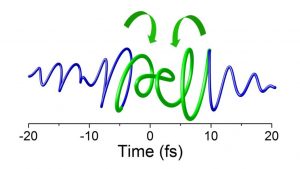Exploiting attosecond light pulses it is now possible to observe in time visible and near-infrared pulses with a complex polarization states.

Light pulses are electromagnetic wave, which are fully described by the evolution in space and time of two vectors: the electric and the magnetic field. During the propagation of a light pulse, these vectors can describe very complex trajectories (for example they can rotate along a circle or describe an ellipse or any mixed combination), which correspond to different polarization states of the radiation. The polarization of an electromagnetic pulse is a key parameter in the light–matter interaction, as it determines the characteristics, for example, of the electrons emitted from atoms, molecules, or solid samples. Observing the “dance” of the electric and magnetic fields is extremely challenging as their motion occurs on the timescale of a few hundreds of attoseconds (1as =10-18 s), which is much faster than any conventional electronic or opto-electronic instrument.
Exploiting a novel approach based on the spatial interference of two isolated attosecond pulses, an international team led by Prof. Dr. Giuseppe Sansone has achieved a full characterization of weak light pulses characterized by a complex evolution of the electric field (as shown in figure).
Attosecond technology is an extremely innovative and powerful tool for the control electronic dynamics and reactions occurring in all states of matter. Using these novel tools, we have generated electronic wave packets lasting only a few hundreds of attoseconds. During their motion electrons are extremely sensitive to external perturbations, and we have exploited this characteristic to gently modify their trajectories using weak visible light pulses. Finally, we have measured the distortions of the electron trajectory, deriving the intensity and the direction of the weak perturbation.
This novel technique offers for the first time the possibility to fully characterize extremely weak visible radiation with a generic polarization state, thus extending visible metrology to a large range of applications. For example, in the future, using our approach, it will be possible to gain complete access to the electronic motion occurring in solids, by measuring the visible light reflected from its surface.
Researchers from the University of Jena, Max-Planck Institute for nuclear Physics in Heidelberg, PTB in Braunschweig, Politecnico Milano, and IFN-CNR in Padua, significantly contributed to these results.
Original publication:
P. A. Carpeggiani et al. (2017): Vectorial optical field reconstruction by attosecond spatial interferometry.
In: Nature Photonics. DOI 10.1038/nphoton.2017.73